The United States has some amazing places to go scuba diving. From the beautiful, clear waters around Hawaii to the shipwrecks off the coast of Florida, there are dive spots perfect for beginners and experienced divers alike.
On this dive adventure across America, you’ll get to see all kinds of incredible marine life up close. Swim alongside gentle manta rays, come face-to-face with sharks, and discover sunken treasures and historical wrecks under the waves.
This blog will be your guide to the very best scuba diving destinations in the USA. You’ll get insider tips on the top dive sites, find out what amazing creatures you might see, and learn how to plan the perfect diving trip.
Get ready to dive in and explore the wonderful underwater worlds right here in the USA. Whether you’re a seasoned pro or just starting out, there’s an unforgettable scuba adventure waiting for you.
Featured Image Credit
Top Spots for Scuba Diving in the USA
Strawberry Wall, Washington
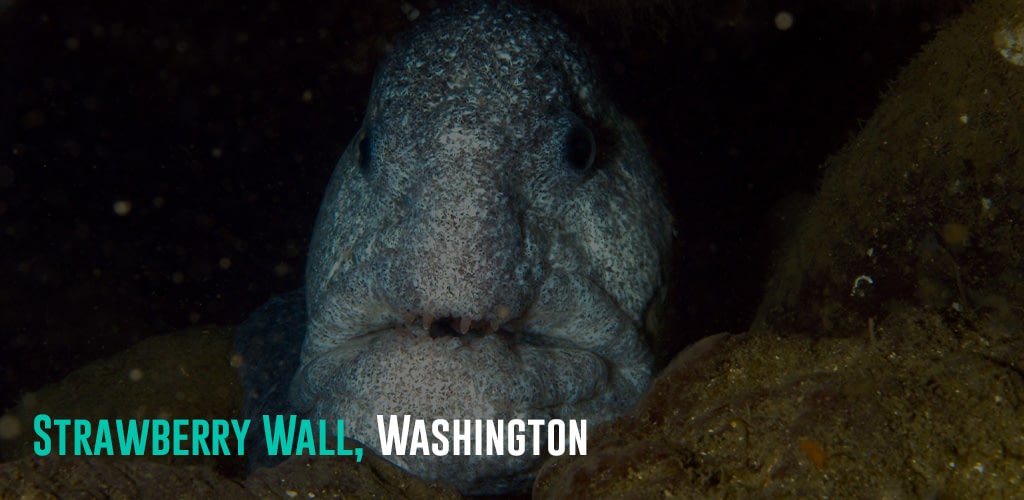
Nestled along the stunning Puget Sound, Strawberry Wall is a must-visit dive site for those exploring the Pacific Northwest. This underwater wall drops dramatically from just 15 feet down to over 100 feet, creating a thrilling dive experience. As you descend, you’ll be greeted by vibrant walls of colorful anemones, sponges, and marine life thriving in the nutrient-rich waters.
Key Points:
- Incredible marine biodiversity, including wolf eels, lingcod, and rockfish
- Explore crevices and overhangs teeming with marine creatures
- Opportunities for advanced drift diving along the wall’s length
Manta Night Dive, Kona, Hawaii
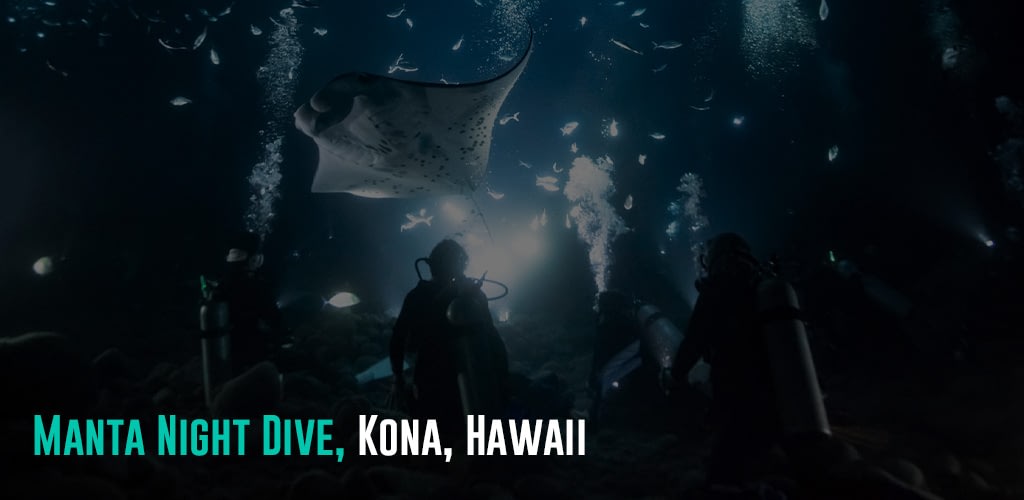
During the evening hours off the Kona Coast of the Big Island, divers have the rare opportunity to witness one of nature’s most mesmerizing displays. Immerse yourself in the inky black waters and shine your dive lights to attract plankton, which in turn attracts vast numbers of majestic manta rays. These gentle giants, with wingspans of up to 16 feet, gracefully glide through the water, feeding on the plankton and providing an up-close encounter like no other.
Key Points:
- Experience the thrill of swimming alongside manta rays in their natural habitat
- Witness the rays’ remarkable acrobatics as they somersault to feed
- An unforgettable night dive experience and a bucket-list item for many divers
Sombrero Reef, Florida Keys National Marine Sanctuary, Florida
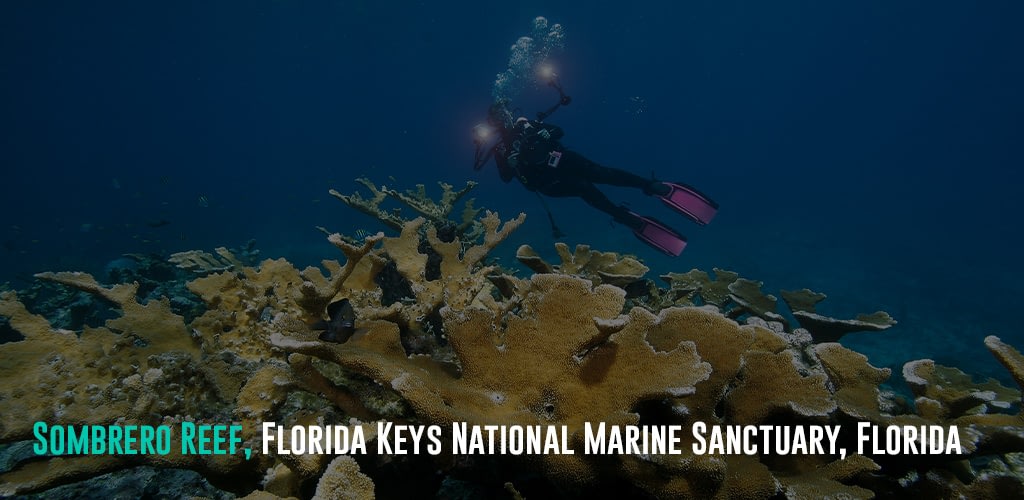
Sombrero Reef, located within the Florida Keys National Marine Sanctuary, is a true gem for scuba divers. This protected coral reef system boasts an incredible diversity of marine life, with colorful sponges, vibrant corals, and an abundance of tropical fish species. As you drift along the reef, keep an eye out for larger residents like reef sharks, sea turtles, and even the occasional passing whale shark.
Key Points:
- Explore stunning elkhorn and staghorn coral formations
- Encounter a wide variety of tropical fish, including angelfish, parrotfish, and butterflyfish
- Drift diving opportunities along the reef’s gentle currents
Catalina Island, California
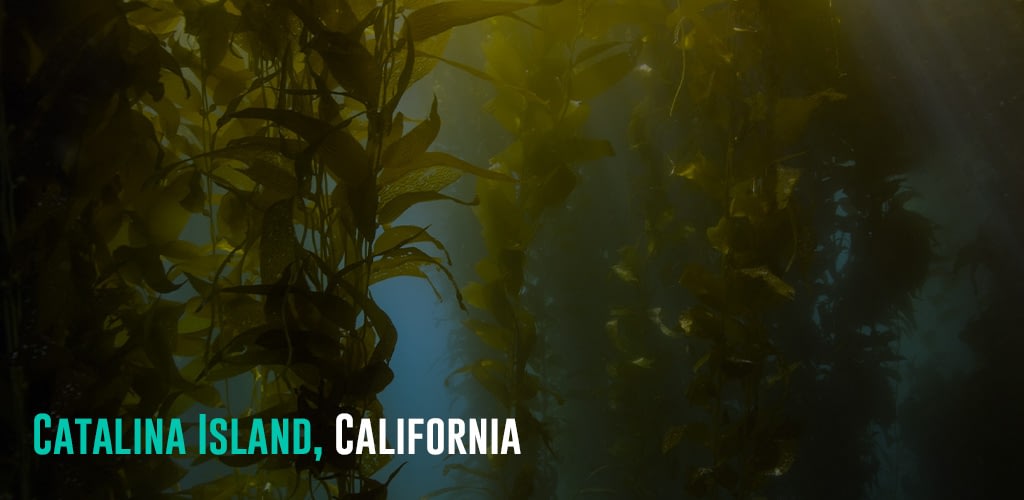
Just off the coast of Southern California lies the picturesque Catalina Island, offering some of the state’s best diving opportunities. Dive into the island’s famous kelp forests, where you’ll encounter a diverse array of marine life, including bright orange garibaldi fish, playful sea lions, and swaying kelp stalks that create an otherworldly underwater landscape. For more advanced divers, the island’s outer reefs provide opportunities to spot larger pelagic species like sharks and rays.
Key Points:
- Explore lush kelp forests and vibrant marine ecosystems
- Encounter friendly sea lions and a variety of fish species
- Experienced divers can explore deeper reefs and potential shark sightings.
HMCS Yukon, San Diego, California
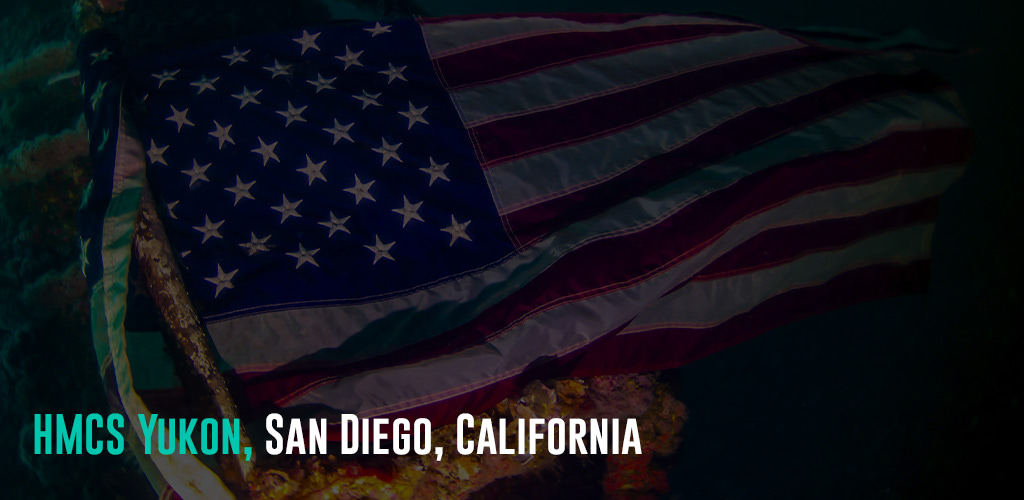
For those seeking an underwater historical adventure, the wreck of the HMCS Yukon, located off the coast of San Diego, is a must-visit dive site. This former Canadian naval destroyer, intentionally sunk in 2000, now serves as an artificial reef teeming with marine life. Swim through the ship’s corridors and explore its deck, now blanketed in colorful sponges, anemones, and schools of fish that call this wreck their home.
Key Points:
- Explore the intact structure of a sunken naval destroyer
- Encounter a diverse array of fish species, including lingcod and rockfish
- Opportunities for penetration diving through the ship’s interior (for experienced divers)
Bonne Terre Mine, Missouri
For a truly unique diving experience, head inland to the flooded Bonne Terre Mine in Missouri. This former lead mine, now filled with crystal-clear water, offers divers the chance to explore an otherworldly underground environment. Descend into the mine’s vast chambers and tunnels, illuminated by your dive lights, and marvel at the surreal rock formations and preserved mining equipment that transport you back in time.
Key Points:
- Explore an underwater mine with vast chambers and tunnels
- Witness preserved mining equipment and machinery from the past
- Experience the thrill of diving in an underground, flooded environment
Key Things to Know Before Diving in the USA
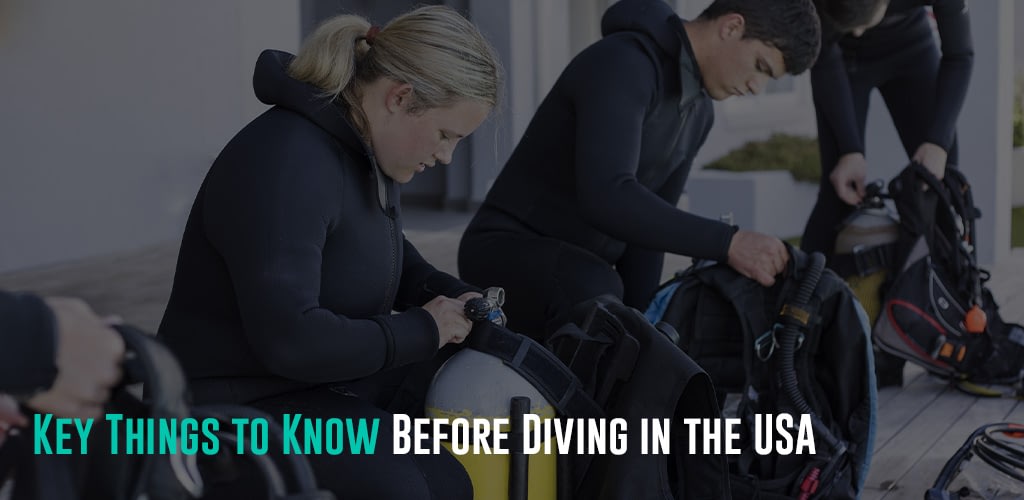
Before starting your scuba diving adventures across the United States, there are several key things to keep in mind. From certification requirements to safety considerations, being well-informed and prepared can ensure a safe and enjoyable diving experience. Understanding local regulations, environmental factors, and dive site conditions is crucial to making the most of your underwater explorations.
- Certification Requirements: Most dive sites in the USA require divers to hold at least an Open Water Diver certification from a recognized agency like PADI, NAUI, or SSI. Some advanced dive sites may require additional certifications, such as Nitrox or Deep Diving.
- Environmental Conditions: Water temperatures can vary significantly across different diving locations in the USA. Be prepared to use appropriate exposure protection (wetsuits, drysuits, etc.) based on the specific conditions of your dive site.
- Marine Life Safety: While the USA offers diverse marine life encounters, it’s important to maintain a respectful distance and avoid harassing or touching any underwater creatures. Familiarize yourself with local wildlife regulations and best practices for responsible diving.
- Local Regulations: Each state and diving location may have specific rules and regulations regarding dive permits, marine protected areas, and other restrictions. Research the local guidelines before planning your dive trips.
- Dive Operators and Guides: Partnering with reputable local dive operators or hiring experienced guides can provide invaluable knowledge about dive site conditions, currents, marine life behavior, and safety protocols specific to each location.
- Equipment Considerations: Depending on the dive site, you may need to adjust your gear configuration. For example, drift diving or strong currents may require additional weights or specialized equipment. Consult with dive professionals to ensure you have the appropriate gear.
By taking the time to understand the unique aspects of diving in the USA, you can better prepare yourself for safe and memorable underwater adventures. Remember, responsible diving practices not only protect yourself but also contribute to the conservation of these precious marine environments for future generations to enjoy.
Best Times of Year for Scuba Diving in the USA
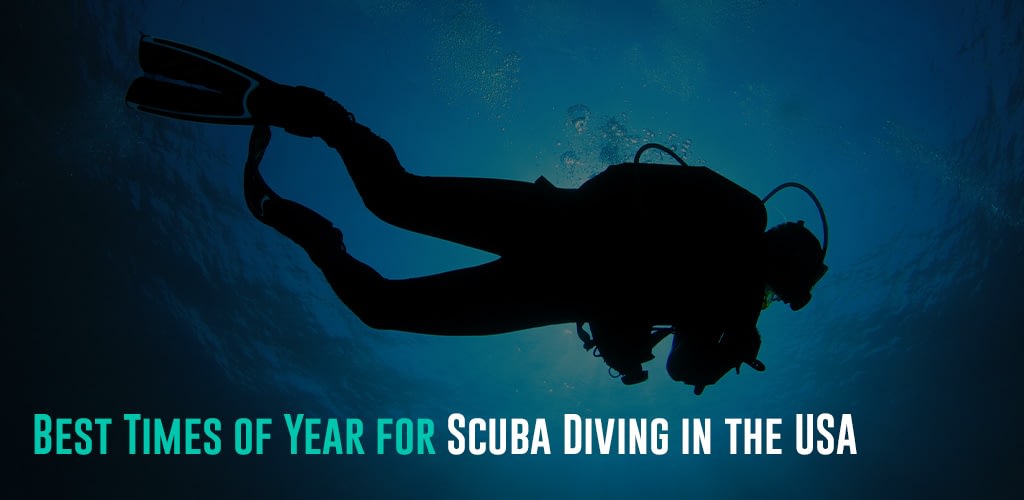
Hawaii:
With its tropical climate and consistently warm waters, Hawaii offers excellent diving opportunities year-round. However, certain seasons can provide unique experiences and increase the chances of encountering specific marine life.
- Winter (December–March): Ideal for spotting humpback whales and their calves during their annual migration
- Summer (June–August): Warm water temperatures and excellent visibility make this a popular time for diving
- Fall (September–November): increased chances of encountering manta rays and whale sharks around the Hawaiian Islands
Florida Keys:
The Florida Keys enjoy a subtropical climate, making it a fantastic year-round diving destination. Still, there are some seasonal variations that can influence the diving experience and marine life encounters.
- Spring (March–May): Mild water temperatures and excellent visibility make this a prime time for diving
- Summer (June–August): warmer water temperatures, but increased chances of spotting sharks and other pelagic species
- Fall (September–November): lower humidity and comfortable air temperatures, with potential for encounters with migrating whale sharks
California:
California’s diverse coastline offers unique diving opportunities throughout the year. The key is to plan your trips around the most favorable conditions for each specific region.
- Northern California (Monterey, Channel Islands): late summer and fall (August–October) provide the best visibility and warmest water temperatures.
- Southern California (Catalina Island, San Diego): Summer (June–August) is the ideal time for diving, with warm water temperatures and good visibility
- Kelp Forest Diving: Late spring and early summer (April–June) offer the best visibility and the chance to witness the kelp forests in full bloom.
Pacific Northwest (Strawberry Wall, Washington):
The Pacific Northwest’s diving season is relatively short due to the cooler water temperatures. However, the summer months offer ideal conditions for exploring sites like Strawberry Wall.
- Summer (June–August): Calm waters, comfortable temperatures, and good visibility make this the prime diving season
- Early fall (September–October): still suitable for diving, but water temperatures start to drop.
- Winter and Spring: Challenging conditions with low visibility and cold water temperatures make diving less appealing.
Inland Diving (Bonne Terre Mine, Missouri):
For inland dive sites like the Bonne Terre Mine, the water temperatures remain consistent throughout the year, making it a year-round diving destination. However, certain times may be more favorable due to factors like crowd levels and visibility.
- Spring and Fall: Fewer crowds and good visibility make these shoulder seasons ideal for diving
- Summer: Warmer air temperatures can make the experience more comfortable, but expect higher visitor numbers.
- Winter: low crowds, but visibility may be reduced due to decreased light levels
Top Marine Life to See While Diving in the USA:
The diverse marine ecosystems found across the United States’ coastlines and inland waterways are home to an incredible array of aquatic life. From vibrant coral reefs teeming with tropical fish to shipwrecks inhabited by curious sea lions, each dive site offers the opportunity to encounter unique and fascinating marine creatures. Whether you’re in search of majestic ocean giants or want to observe the intricate behaviors of smaller species, the USA has something to captivate every underwater explorer.
- Sharks: From the graceful reef sharks of the Florida Keys to the mighty great white sharks off the coast of California, the USA offers numerous opportunities to witness these apex predators in their natural habitats.
- Sea Turtles: Gracefully gliding through the waters, sea turtles like the green and hawksbill turtles can be spotted in areas like Hawaii and the Florida Keys, where they forage on coral reefs and seagrass beds.
- Manta Rays: Witness the mesmerizing acrobatics of these gentle giants during night dives in Hawaii, where they perform somersaults to feed on plankton attracted by dive lights.
- Whales and Dolphins: Keep an eye out for the annual migration of humpback whales in Hawaii, or catch a glimpse of playful bottlenose dolphins swimming alongside divers in destinations like Florida and California.
- Colorful Reef Fish: From the vibrant angelfish and parrotfish of the Florida Keys to the bright orange garibaldi fish of California’s kelp forests, the USA offers a kaleidoscope of tropical and temperate fish species to admire.
- Sea Lions and Seals: Encounter the curious and charismatic sea lions of Catalina Island, or spot harbor seals resting on rocky outcroppings along the coasts of the Pacific Northwest.
Conclusion:
Scuba diving in the United States offers an incredible variety of underwater adventures, from exploring vibrant coral reefs and kelp forests to encountering majestic marine life and discovering historical shipwrecks. Whether you’re a seasoned diver or just starting, the USA has something to captivate every underwater explorer.
From the Pacific Northwest’s nutrient-rich waters and dramatic walls to the crystal-clear cenotes of Florida and the lush kelp forests of California, each dive site provides a unique and unforgettable experience. Swim alongside gentle giants like manta rays and whale sharks, come face-to-face with curious sea lions, and discover sunken treasures that transport you back in time.
As you plan your next diving adventure across the United States, remember to research local regulations, environmental conditions, and dive site specifics to ensure a safe and responsible exploration of these precious underwater worlds.
Travel-wise, we know planning a trip is exciting, but it can also feel confusing with so many things to organize. A good trip planning tool makes it much easier. The Travel-Wise Trip Planner app lets you easily build trip itineraries, manage your budget, and share trip details. It has helpful features that save you time when planning your next adventure. If you want to be wise in your travels, learn more about how the Trip Planner works. Or just start using it now to plan your next fun trip! The Travel Wise tools help you make your dream trip happen. When will you go on your next scuba diving adventure?


